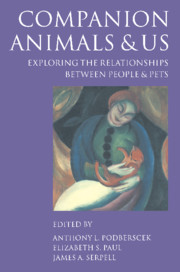Book contents
6 - The horse bar mitzvah: a celebratory exploration of the human–animal bond
from Part I - History and culture
Summary
INTRODUCTION
I confess. It took years before I located the Long Island, New York woman who gave the horse bar mitzvah. Even though the New York NBC-TV sports department confirmed that in December 1993 they had featured several sound bytes on the celebrated steed and his owner, by the time I contacted them, the station no longer had any backup information. All I knew was that at the ceremony, the 13-year-old horse wore a yarmulke (Jewish skull cap). Despite the missing information, I clung to the name because of the seemingly absurd juxtaposition of those words. I was rewarded for holding on to the phrase when over time I discovered a cat mitzvah and a bark mitzvah for a 13-year-old Labrador retriever whose 20 dog guests received monogrammed hats to wear at a barbecue reception.
The horse bar mitzvah presents an incongruous pairing of a solemn religious ceremony with an unexpected participant. The idea is startling, risky, yet useful in making people consider human–animal relationships from a different perspective. The purpose is to focus on rites of passage and other rituals, especially those taking place at holiday times. Such celebrations reveal a complex relationship between humans and animals. Folklorists often examine rites of passage, customs, beliefs and ceremonies to understand human behaviour and culture. I am no exception. This has been the foundation of my research, teaching, and writing for over 25 years.
Why do people impose human celebrations on other species? Is it merely an expression of human imperialism? Or is it because urban America has no ready-made outlets for expressing love for other creatures? To investigate this phenomenon, I conducted interviews at two different Blessing of the Animals ceremonies. I observed a Halloween ‘Boo at the Zoo’, National Pet Cemetery Day, and a graduation at Guide Dogs of America. I conferred with grief counsellors working with zoo employees following the Philadelphia Zoo fire in which 23 primates died, questioned hosts of a cat mitzvah and a dog wedding, a cat owner who sat Shiva (a Jewish mourning custom) for her deceased pet, participants at a reptile exposition, basset hound picnic, and a lobster wedding. This is only a fragment of the data base used to document a variety of human rituals for animals.
- Type
- Chapter
- Information
- Companion Animals and UsExploring the relationships between people and pets, pp. 90 - 107Publisher: Cambridge University PressPrint publication year: 2000



